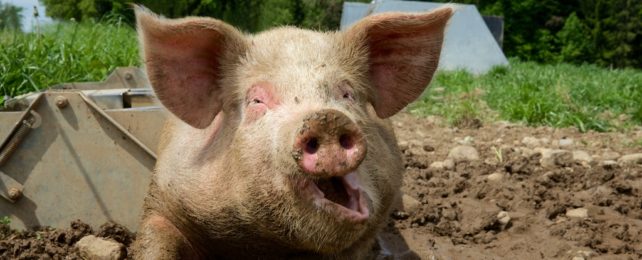Scientists have successfully restored erectile function in pigs with penis injuries using artificial tissue.
"We were […] surprised by the results in the animal experiments, where the penis regained normal erection immediately," says tissue engineer Xuetao Shi from South China University of Technology.
About half of all humans with penises experience some form of erectile dysfunction between the ages of 40 and 70. Some of those experience Peyronie's disease, where scar tissues from past injuries cause pain and disruption in function.
This is usually treated by grafting tissues from other parts of the patient's body into the penis to replace the damaged area. But our immune systems are good at rejecting insertions of biological materials, and even successful grafts can lead to problems like penis shortening because of differences between tissue types.
So South China University of Technology tissue engineer Muyuan Chai and colleagues have turned to synthetic tissues as a potential alternative.
Spongy mammalian erectile tissues are scaffolded by wavy collagen fibers (with a little bit of elastin) stacked parallel to each other, called tunica albuginea (TA). When the spongy tissues swell with blood, these fibers allow for extra room while still holding everything together by straightening out.
As the TA fibers reach their full length and then stretch, they also create firmness, acting as a hydrostatic skeleton that controls and limits the shape change and resists external deformation.
The researchers constructed a synthetic mimic of these fibers by testing different compositions on a balloon model. They found stretching isotropic polyvinyl alcohol gel and adding crosslinks to keep the resulting fibers in a parallel alignment produced the same directional expansion and stretch as TA, which creates the soft-to-firm transition seen in the erectile tissue as a whole.
Chai and the team called their bionic creation an artificial tunica albuginea (ATA). It can undergo cyclic bursts of relaxing and stretching while resisting fatigue, maintaining toughness, and withstanding needle punctures during suturing.
They then tested their synthetic tissue in pigs with TA injuries.
"The results one month after the procedure showed that the ATA group achieved good, though not perfect, repair results," says Shi.
While ATA couldn't fully restore the complete intricate structure of natural tissue, as it did not replace the function of the other tissues also involved, like blood vessels, it was still able to repair normal erectile function in the pigs after a saline injection, as demonstrated in video footage taken by the team.
"Our work at this stage focuses on the repair of a single tissue in the penis, and the next stage will be to consider the repair of the overall penile defect or the construction of an artificial penis from a holistic perspective," Shi explains.
While there's still a way to go before such technology can be used by humans, this research increases our understanding of tough yet shape-shifting materials.
What's more, "this design approach is not limited to the biomimetic design of tunica albuginea tissues but can be extended to many other load-bearing tissues," says Shi.
This is because most load-bearing soft tissues share similar traits to the tunica albuginea with their curly aligned fibers that provide the mechanical properties for their function. Such tissue can be found in blood vessels and the intestine, cornea, bladder, tendons, and heart, so a similar strategy could also be applied to help repair them.
This research was published in Matter.
